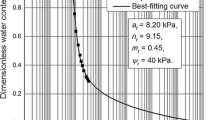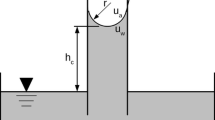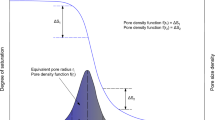Abstract
A new framework is proposed for predicting thermal conductivity dry out curves (TCDC) quantifying the relationship between soil thermal conductivity and degree of saturation at non-elevated temperatures. Pore-scale expressions are derived to quantify water retention and corresponding conductive heat transport for an idealized contacting-sphere geometry approximating that of granular (sand-sized) porous media. Measured water retention behavior is used to constrain a simulated soil–water characteristic curve and corresponding TCDC by differentiating pores containing water in the form of inter particle liquid bridges from pores containing water in the form of saturated pockets. Modeled TCDCs compare well with experimental measurements for representative fine-, medium-, and coarse-grained sands. Predicted thermal conductivity is within 5–10 % of the full scale range for saturations greater than 20 %. Model predictions perform as well as or better than predictions made using many existing empirical approaches. Because the model directly incorporates basic soil properties and process variables in its formulation, including grain size, grain size distribution, and wetting direction, it becomes a potentially useful framework to improve understanding of fundamental controls on soil thermal conductivity.









Similar content being viewed by others
Abbreviations
- C c :
-
Coefficient of curvature
- C u :
-
Coefficient of uniformity
- d 50 :
-
Median grain size by mass
- e :
-
Void ratio
- g :
-
Campbell et al. (1994) TCDC modeling function
- G s :
-
Specific gravity of soil solids
- m c :
-
Clay content
- n :
-
Porosity; mixing model exponent
- q t :
-
Heat flux
- r 1 :
-
Radius in toroidal approximation for liquid bridge
- r 2 :
-
Radius in toroidal approximation for liquid bridge
- R :
-
Spherical particle radius
- R min :
-
Minimum particle radius in f(R)
- R max :
-
Maximum particle radius in f(R)
- R fill :
-
Particle radius in f(R) corresponding to snap off
- R 2 :
-
Coefficient of determination
- S :
-
Degree of saturation
- T s :
-
Air-water interfacial tension
- V a :
-
Volume of air
- V s :
-
Volume of soil solids
- V t :
-
Volume total
- V w :
-
Volume of water
- w :
-
Gravimetric water content
- x f :
-
Fractional area of liquid bridge
- α :
-
Fitting parameter in Hu et al. (2001) TCDC model; contact angle
- κ :
-
Kersten number
- λ :
-
Thermal conductivity
- λ a :
-
Thermal conductivity of air
- λ p :
-
Pore-scale thermal conductivity
- λ q :
-
Thermal conductivity of quartz
- λ s :
-
Thermal conductivity of mineral solids
- λ w :
-
Thermal conductivity of water
- λ dry :
-
Thermal conductivity at dry conditions
- λ sat :
-
Thermal conductivity at full saturation
- θ :
-
Volumetric water content
- θ crit :
-
Volumetric water content at snap-off
- θ o :
-
Cut-off water content for liquid return flow, Campbell et al. (1994)
- ρ b :
-
Dry bulk soil density
- ρ s :
-
Density of soil solids
- ψ :
-
Soil suction
- μ :
-
Mean particle radius in f(R)
- σ :
-
Standard deviation of particle radius in f(R)
References
Adam D, Markiewicz R (2009) Energy from earth-coupled structures, foundations, tunnels and sewers. Géotechnique 59(3):229–236
Bico J, Quéré D (2002) Rise of liquids and bubbles in angular capillary tubes. J Colloid Interface Sci 247:162–166
Brandl H (2006) Energy foundations and other thermo-active ground structures. Géotechnique 56(2):81–122
Brandon TL, Mitchell JK, Cameron JT (1989) Thermal instability in buried cable backfills. J Geotech Eng ASCE 115(1):38–55
Campbell GS, Jungbauer JD, Bidlake WR, Hungerford RD (1994) Predicting the effect of temperature on soil thermal conductivity. Soil Sci 158(5):307–313
Cho GC, Santamarina JC (2001) Unsaturated particulate materials: particle-level studies. J Geotech Geoenviron Eng ASCE 127(1):84–96
Côté J, Konrad J-M (2005) A generalized thermal conductivity model for soils and construction materials. Can Geotech J 42:443–458
Côté J, Konrad J-M (2009) Assessment of structure effects on the thermal conductivity of two-phase porous geomaterials. Int J Heat Mass Transf 52:796–804
Ewing RP, Horton R (2007) Thermal conductivity of a cubic lattice of spheres with capillary bridges. J Phys D Appl Phys 40:4959–4965
Farouki O (1981) Thermal properties of soils. CRREL Monograph 81-1, US Army Corps of Eng., Cold Regions Research and Eng. Laboratory, Hanover, NH
Gemant A (1950) The thermal conductivity of soils. J Appl Phys 21:750–752
Hu X-J, Du J-H, Lei S-Y, Wang B-X (2001) A model for the thermal conductivity of unconsolidated porous media based on capillary pressure-saturation relation. Int J Heat Mass Transf 44:247–251
Johansen O (1975) Thermal conductivity of soils. Ph.D. Thesis, Institute for Kjoleteknikk, Trondheim, Norway, (CRREL Draft Translation 637, 1977)
Johnston IW, Narsilio GA, Colls S (2011) Emerging geothermal energy technologies. KSCE J Civil Eng 15(4):643–653
Kersten MS (1949) Laboratory research for the determination of the thermal properties of soils. Research Laboratory Investigations, Engineering Experiment Station, University of Minnesota, Minneapolis, MN, Technical Report 23
Likos WJ (2013) Modeling thermal conductivity dryout curves from soil–water characteristic curves. J Geotech Geoenviron Eng. 10.1061/(ASCE)GT.1943-5606.0001078, 04013056
Likos WJ (2014) Effective stress in unsaturated soil: accounting for surface tension and interfacial area. Vadose Zone J. doi:10.2136/vzj2013.05.0095
Likos WJ, Jaafar R (2013) Pore-scale model for water retention and fluid microstructure of partially saturated coarse-grained soil. J Geotech Geoenviron Eng 139(5):724–737
Likos WJ, Lu N (2004) Hysteresis of capillary stress in unsaturated granular soil. J Eng Mech 130(6):646–655
Likos WJ, Olson HS and Jaafar R (2012) Comparison of laboratory methods for measuring thermal conductivity of unsaturated soils. In: Proceedings of GeoCongress 2012, ASCE, Oakland, California
Likos WJ, Lu N, and Godt JW (2014) Hysteresis and uncertainty in soil-water retention curve parameters. J Geotech Geoenviron Eng. doi:10.1061/(ASCE)GT.1943-5606.0001071, 04013050
Lu N, Likos WJ (2004) Unsaturated soil mechanics. Wiley, New York
Lu S, Ren TS, Gong YS, Horton R (2007) An improved model for predicting soil thermal conductivity from water content at room temperature. Soil Sci Soc Am J 71:8–14
Mason G, Morrow N (1991) Capillary behavior of a perfectly wetting liquid in irregular triangular tubes. J Colloid Interface Sci 149(1):262–274
Millington RJ, Quirk JP (1961) Permeability of porous media. Nature 183:387–388
Mualem Y (1976) A new model for predicting the hydraulic conductivity of unsaturated porous media. Water Resour Res 12(3):513–522
Olgun CG, Martin JR, Bowers GA (2012) Energy piles: using deep foundations as heat exchangers. Geo-Strata Geo Inst ASCE 13(2):46–51
Or D, Tuller M (1999) Liquid retention and interfacial area in variably saturated porous media: upscaling from single-pore to sample-scale model. Water Resour Res 35(12):3591–3605
Powers MC (1982) Comparison charts for estimating roundness and sphericity. AGI Data Sediment Petrol 23(2):117–119
Schroth MH, Ahearn SJ, Selker JS, Istok JD (1996) Characterization of Miller-similar silica sands for laboratory hydrologic studies. Soil Sci Soc Am J 60:1331–1339
Smits KM (2010) Non-isothermal soil moisture processes in the shallow subsurface influenced by atmospheric boundary conditions: Numerical and experimental study. PhD Dissertation, Colorado School of Mines, Environmental Science and Engineering, Golden, CO
Smits KM, Sakaki T, Limsuwat A, and Illangasekare TH (2009) Determination of the thermal conductivity of sands under varying moisture, drainage/wetting, and porosity conditions: applications in near-surface moisture distribution analysis. In: Proceedings of AGU Hydrology Days 2009
Smits KM, Sakaki T, Limsuwat A, Illangasekare TH (2010) Thermal conductivity of sands under varying moisture and porosity in drainage—wetting cycles. Vadose Zone J 9(1):1–9
Smits KM, Sakaki T, Howington SE, Peters JF, Illangasekare TH (2012) Temperature dependence of thermal properties of sands across a wide range of temperatures (30–70 °C). Vadose Zone J. doi:10.2136/vzj2012.0033
Somerton WH, El-Shaarani AH, and Mobarak SM (1974) High temperature behavior of rocks associated with geothermal type reservoirs. In: Paper SPE-4897, 44th Annual California Regional Meeting of the Society of Petroleum Engineers, San Francisco, California
Tuller M, Or D, Dudley LM (1999) Adsorption and capillary condensation in porous media: liquid retention and interfacial configurations in angular pores. Water Resour Res 35(7):1949–1964
van Genuchten MT (1980) A closed form equation for predicting the hydraulic conductivity of unsaturated soils. Soil Sci Soc Am J 44:892–898
Willson CS, Lu N, Likos WJ (2012) Quantification of grain, pore, and fluid microstructure of unsaturated sand from X-ray computed tomography images. Geotech Test J 35(6):911–923
Acknowledgments
This material is based upon work supported by the National Science Foundation (NSF) under Grant CMMI 0968768. Any opinions, findings, and conclusions or recommendations expressed in this material are those of the authors and do not necessarily reflect the views of NSF.
Author information
Authors and Affiliations
Corresponding author
Rights and permissions
About this article
Cite this article
Likos, W.J. Pore-Scale Model for Thermal Conductivity of Unsaturated Sand. Geotech Geol Eng 33, 179–192 (2015). https://doi.org/10.1007/s10706-014-9744-9
Received:
Accepted:
Published:
Issue Date:
DOI: https://doi.org/10.1007/s10706-014-9744-9




